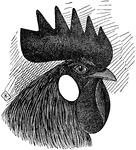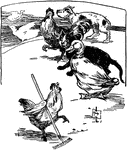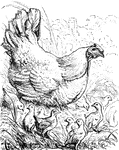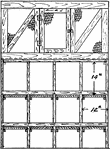Clipart tagged: ‘hen’

Animals Looking Through Window
An illustration of a hen, cat, dog and horse standing on top of one another to see into a window.

Head of Single-Comb Brown Leghorn Cock
"The comb is single, of medium size, perfectly straight and upright upon the head, free from side sprigs,…

Egg Germination
"Further development of hen's egg; after Haeckel: A, the mulberry mass of cleavage cells, b, same as…

Hen Raking Barnyard with Animals Watching
An illustration of a hen raking the barnyard while a goose, cat, two dogs, and a hen watch.

Hen's Egg
" Fig 110 - Hens egg, nat. size, in section; from Owen, after A. Thompson. A, cicatricle or "tread,"…

Blue Andalusian Hen
Andalusians are generally classified as "Mediterranean" chickens. They are relatively rare, and can…

Prairie Hens
Prairie hens feed on grasshoppers, wheat, corn, seeds, and the buds of trees. They are also known as…

Pair of Black Javas
Originated in the United States. It is one of the oldest American chickens, and is critically endangered…

Jungle-fowl
Jungle-fowl is a general name given to the members of the genus Gallus. The red jungle-fowl, G. jerrugineus,…

Lumpfish
"It is of thick, massive form, and often weighs as much as six or seven pounds; it is of a purplish-black…

Moorhen
Also known as the waterhen, the moorhen lives around rivers and lakes, feeding on worms, insects, mollusca,…

Mother Hen & Baby Chicks
An illustration of a mother hen and her baby chicks eating grain out of a bowl.

Nature Will Out
"A fine old hen some ducks and chickens hatch'd, / And with a mother's care their safety watch'd; /…

Petits! Petits! Petits! Foraging in an Enemy's Country
"Petits! Petits! Petits! Foraging in an Enemy's Country. From the drawing by Horace Vernet." -Rees,…

Pochard
The pochard (or dun-hen) averages about nineteen and a half inches in length, and is found in parts…

Reynard the Fox: Taunting Bruin
Reynard the Fox taunts Bruin the Bear who is hurt after getting his head stuck in a tree to get honey.

























